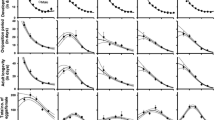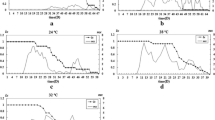Abstract
Development time, reproduction, survival and sex ratio were determined for the omnivorous mite Amblyseius swirskii at nine constant temperatures (13, 15, 18, 20, 25, 30, 32, 34 and 36°C) on pepper leaf disks with cattail, Typha latifolia, pollen for food. These data were used to derive life table parameters at these constant temperatures. No development was observed at 13°C. The lower development threshold, based on the fit to the linear portion of the development curve, was 11.3°C. The upper development threshold was 37.4 ± 1.12°C, and the optimum temperature was calculated to be 31.5°C. Average lifetime fecundity ranged from a low of 1.3 ± 0.24 eggs/female at 15°C to a high of 16.1 ± 0.34 eggs/female at 25°C, and r m was greatest at 32°C. Non-linear regression of the relationship between temperature and r m produced an estimate of 15.49 ± 0.905°C for the lower threshold for population growth and 36.99 ± 0.816°C for the upper threshold for population growth, and an optimum temperature of 30.1°C. These values suggest that A. swiskii populations should grow quickly in response to food availability (pollen or prey) between 20 and 32°C, but that, especially below 20°C, population growth could be slow and impacts on prey populations should be monitored carefully.

Similar content being viewed by others
References
Abou-Awad BA, Reda AS, Elsawi SA (1992) Effects of artificial and natural diets on the development and reproduction of two phytoseiid mites Amblyseius gossipi and Amblyseius swirskii (Acari: Phytoseiidae). Insect Sci Appl 13:441–445
Abou-Awad BA, El-Sawaf BA, Abdel-Khalek AA (1999) Impact of two eriophyoid fig mites, Aceria ficus and Rhyncaphytoptus ficifoliae, as prey on postembryonic development and oviposition rate of the predacious mite Amblyseius swirskii. Acarologia 40:364–371
Anton S, Dufour MC, Gadenne C (2007) Plasticity of olfactory-guided behaviour and its neurobiological basis: lessons from moths and locusts. Entomol Exp Appl 123:1–11
Bensadia F, Boudreault S, Guay JF, Michaud D, Cloutier C (2006) Aphid clonal resistance to a parasitoid fails under heat stress. J Insect Physiol 52:146–157
Briere JF, Pracros P, Le Roux AY, Pierre JS (1999) A novel rate model of temperature-dependent development for arthropods. Environ Entomol 28:22–29
British Columbia Greenhouse Growers’ Association and Province of British Columbia Ministry of Agriculture, Food and Fisheries (2005) Growing Greenhouse Peppers in British Columbia. A Production Guide for Commercial Growers, 189 pp
Campbell A, Frazer BD, Gilbert N, Gutierrez AP, Mackauer M (1974) Temperature requirement of some aphids and their parasites. J Appl Ecol 11:431–438
Chi H (1988) Life table analysis incorporating both sexes and variable development rates among individuals. Environ Entomol 17:26–34
Chi H, Liu H (1985) Two new methods for the study of insect population ecology. Bull Inst Zool Academia Sinica 24:225–240
Clarke A (2003) Costs and consequences of evolutionary temperature adaptation. Trends Ecol Evol 18:573–581
Cloutier C, Arodokoun D, Johnson S, Gélinas L (1995) Thermal dependence of Amblyseius cucumeris (Acarina, Phytoseiidae) and Orius insidiosus (Heteroptera: Anthocoridae) in greenhouses: thrips biology and management. In: Parker BL, Skinner M, Lewis T (eds) Plenum Press, New York, pp 231–235
Easterbrook MA, Fitzgerald JD, Pinch C, Tooley J, Xu XM (2003) Development times and fecundity of three important arthropod pests of strawberry in the United Kingdom. Ann Appl Biol 143:325–331
El-Laithy AYM, Fouly AH (1992) Life table parameters of the two phytoseiid predators Amblyseius scutalis A. H. and Amblyseius swirskii A. H. Acari Phytoseiidae in Egypt. J Appl Entomol 113:8–12
Goodman D (1982) Optimal life histories, optimal notation, and the value of reproductive value. Am Naturalist 119:803–823
Hagstrum DW, Milliken GA (1991) Modeling differences in insect developmental times between constant and fluctuating temperatures. Ann Entomol Soc Am 84:369–379
Hoda FM, El-Naggar ME, Taha AH, Ibrahim GA (1987) Effect of different types of food on fecundity of predacious mite Amblyseius swirskii A.-H. (Acari: Phytoseiidae). Bulletin Societe Entomologique-d’-Egypte 66:113–116
Hoogerbrugge H, Calvo J, van Houten Y, Bolckmans K (2005) Biological control of the tobacco whitefly Bemisia tabaci with the predatory mite Amblyseius swirskii in sweet pepper crops. Bull OILB/SROP 28(1):119–122
Hulspas-Jordaan PM, van Lenteren JC (1989) The parasite-host relationship between Encarsia formosa (Hymenoptera: Aphelinidae) and Trialeurodes vaporariorum (Homoptera: Aleyrodidae). XXX. Modelling population growth of greenhouse whitefly on tomato. Agricultural University. Wageningen Papers 89–2:1–54
Hulspas-Jordaan PM, Christochowitz EE, Woets J, van Lenteren J (1987) The parasite-host relationship between Encarsia formosa (Hymenoptera: Aphelinidae) and Trialeurodes vaporariorum (Homoptera: Aleyrodidae). XXIV. Effectiveness of Encarsia formosa in the greenhouse at low temperatures. J Appl Entomol 103:368–378
Illinois Natural History Survey (2004) Clearinghouse for ecological software. Ecological software by Hsin Chi. http://nhsbig.inhs.uiuc.edu/wes/chi.html. Accessed August 2007
Kasap I, Şekeroğlu E (2004) Life history of Euseius scutalis feeding on citrus red mite Panonychus citri at various temperatures. Biocontrol 49:645–654
Katayama H (1997) Effect of temperature on development and oviposition of western flower thrips Frankliniella occidentalis (Pergande). Jpn J Appl Entomol Zool 41:225–231
Lee JH, Ahn JJ (2000) Temperature effects on development, fecundity, and life table parameters of Amblyseius womersleyi (Acari: Phytoseiidae). Environ Entomol 29:265–271
Logan JA, Wollkind DJ, Hoyt SC, Tanigoshi LK (1976) An analytic model for description of temperature dependent rate phenomena in Arthropods. Environ Entomol 5:1133–1140
Marquardt D (1963) An algorithm for least-squares estimation of nonlinear parameters. SIAM J Appl Math 11:431–441
Messelink GJ, van Steenpaal S, van Wensveen W (2005) Typhlodromips swirskii (Athias-Henriot) (Acari: Phytoseiidae): a new predator for thrips control in greenhouse cucumber. Bull OILB/SROP 28(1):183–186
Messelink G, Sebastiaan EF, van Steenpaal S, Ramakers PMJ (2006) Evaluation of phytoseiid predators for control of western flower thrips on greenhouse cucumber. Biocontrol 51:753–768
Metwally A, Abou-El-Naga M, Hoda FM (1984) Studies on feeding reproduction and development of Amblyseius swirskii (Acarina: Phytoseiidae). Agric Res Rev 62:324–326
Nomikou M, Janssen A, Schraag R, Sabelis MW (2001) Phytoseiid predators as potential biological control agents for Bemisia tabaci. Exp Appl Acarol 25:271–291
Nomikou M, Janssen A, Sabelis MW (2003) Phytoseiid predators of whiteflies feed and reproduce on non-prey food sources. Exp Appl Acarol 31:15–26
Nothnagl M, Kosiba A, Alsanius BW, Anderson P, Larsen RU (2008) Modelling population dynamics of Frankliniella occidentalis (Pergande) (Thysanoptera: Thripidae) on greenhouse grown chrysanthemum. Eur J Hortic Sci 73:12–19
Park HH, Shipp L, Buitenhuis R (2010) Predation, development, and oviposition by the predatory mite Amblyseius swirskii (Acari: Phytoseiidae) on tomato russet mite (Acari: Eriophyidae). J Econ Ent 103:563–569
Romeih AHM, El Saidy E, El Arnaouty SA (2004) Suitability of Ephestia kuehneilla and Corycera cephalonica eggs as alternative preys for rearing predatory mites. Egypt J Biol Pest Control 14:101–105
Roy MA, Brodeur JB, Cloutier CC (2002) Relationship between temperature and developmental rate of Stethorus punctillum (Coleoptera: Coccinellidae) and its prey Tetranychus mcdanieli (Acarina: Tetranychidae). Environ Entomol 31:177–187
Stenseth C (1979) Effect of temperature and humidity on the development of Phytoseiulus persimilis and its ability to regulate populations of Tetranychus urticae (Acarina: Phytoseiidae, Tetranychidae). Entomophaga 24:311–317
Swirski E, Amitai S, Dorzia N (1967) Laboratory studies on the feeding, development and oviposition of the predacious mite Amblyseius rubini Swirski and Amitai and Amblyseius swirski Athias-Henriot (Acari: Phytoseiidae) on various kinds of food substances. Israel J Agric Res 17:101–119
Trudgill DL, Honek A, Li D, van Straalen NM (2005) Thermal time—concepts and utility. Ann Appl Biol 146:1–14
Tsoukanas VI, Papadopoulos GD, Fantinou AA, Papadoulis GT (2006) Temperature-dependent development and life table of Iphiseius degenerans (Acari: Phytoseiidae). Environ Entomol 35:212–218
van Roermund HJW, van Lenteren JC (1992) The parasite-host relationship between Encarsia formosa (Hymenoptera: Aphelinidae) and Trialeurodes vaporariorum (Homoptera: Aleyrodidae) XXXIV. Life-history parameters of the greenhouse whitefly, Trialeurodes vaporariorum as a function of host plant and temperature. Wageningen Agricultural University Papers 92–3
Wimmer D, Hoffmann D, Schausberger P (2008) Prey suitability of western flower thrips, Frankliniella occidentalis, and onion thrips, Thrips tabaci, for the predatory mite Amblyseius swirskii. Biocontrol Sci Technol 18:541–550
Yousef AE, El-Keifl AH, Metwally AM (1982) Zur Wirkung von Temperatur und Photoperiode auf die Entwicklung, Ernährung und Eiablage der Raubmilbe Amblyseius swirskii Ath. Henr. (Acari, Gamasida, Phytoseiidae). Anzeiger Schadlingskunde Pflanzenschutz Umweltschutz 55:107–109
Acknowledgments
We thank Dr. Hsin Chi for generous help and for valuable comments and suggestions on data analysis. We thank three anonymous reviewers for thoughtful comments that greatly improved the final verion of the manuscript. We thank Agriculture and Agri-Food Canada and Gyeongsangnam-do Province Government, Korea, for providing funding and operational support that made this research possible.
Author information
Authors and Affiliations
Corresponding author
Rights and permissions
About this article
Cite this article
Lee, HS., Gillespie, D.R. Life tables and development of Amblyseius swirskii (Acari: Phytoseiidae) at different temperatures. Exp Appl Acarol 53, 17–27 (2011). https://doi.org/10.1007/s10493-010-9385-5
Received:
Accepted:
Published:
Issue Date:
DOI: https://doi.org/10.1007/s10493-010-9385-5




